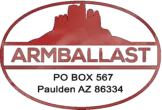SANDSTONE CANYON
This is a method of creating a “Tough Skin” scenery shell that is lightweight and less messy than plaster. I now use a two-layer process with spray foam in between the back and front paper. The foam allows some density for planting trees, fence post and whatever for stability. Every now and then at the groceries store, I ask to have my purchases bagged in paper bags. Open up the bag at the bottom and cut out pieces that fit your scenery situation. There is a seam in the bag, so I use this for the first layer that won’t be seen. I use Carpenters wood glue for securing the edges in place. Follow the instructions below for a detail of the method. Crumple up a paper shopping bag and then open it up. I cut a section of it to fit the scenery slope at left. It was first glued along the edge of the sub roadbed and allowed to dry. Now the bottom edge is glued in place on the lower bench work. A paper flap was also glued to the edge of the viaduct and allowed to dry. This will later be folded over and glued to the other vertical paper bag. After the photo was taken, more bag material was added at the right until it met the existing scenery. A piece of Styrofoam was glued in place so the paper flap can be folded over and glued in place without collapsing the adjacent paper. You can install cardboard or Styrofoam supports every so often behind this shell system. I do it only when the scenery is at a more gradual slope for strength. The second layer of paper is glued at the bottom edge only because I’m going to start filling in between the layers with spray Foam. That second layer of paper is held open with the tape measure just for the picture. I thought it best to keep all the store brand printing on the backside from the side that will show. One can of foam do about four square feet of scenery shell.
It’s best to have that much area ready so the entire can will be used up. A second area was readied for foaming so I could use up the entire can of foam. The top paper is glued at the bottom edge and pulled back for the picture. The paper on the other side of the track is also doubled and will be pulled back for foaming. The foam was sprayed in full-length rows starting at the bottom and stacked just short of the top. I quickly raised up the paper and glued it at the top. The foam will expand to twice its size as you can see the bulging of the paper after it cured a couple of hours. I will use some plaster of Paris to fill in the gaps as you see in the photo above. The same was done in this second area also. The carpenters wood glue was used to attach the paper after it was filled with foam. I spray the unruly paper with water to make it softer for laying against the foam underneath. Very important step Immediately after Plaster of Paris was applied to close up the joints, I bushed on a soupy mixture of scenery color and texture. For this, I used Cajon Powder and diluted glue. The mixing bowl and stiff brush are seen in the photo centre. As I worked, the plaster began to harden so the color brushing continued until the white plaster was coloured over. A second coat touch up was done in a few places to tone down the white of the plaster. I don’t want the plaster to come loose and fall off the paper. The glue mixture with powder will create a lasting bond as it somewhat mixes with the fresh plaster. One 11 ounce package of #1200 Cajon Rock Powder was enough to color the scene at left and below. Some of the “white” from the plaster shows through that gives the rock face interesting highlights. Immediately, the rest of the powder was sprinkled over the still wet scenery. Then some “Zip Texturing of #1203 Sand & Gravel, #2 Dead & Alive ground cover, #9 Fine Green Blend Grass and #1205, 1207 Cajon Rip/rap material. End it up by lightly spraying with wetted water and dripping on the diluted glue. Gradual slopes as this hold the loose rock as in nature. The very four ground, back scenery and backdrop painting are not finished yet for this article. When that is ready, I’ll plant many of the trees I’m working on. The next tutorial will cover the topic of preparing this same terrain for the planting of brush and trees.
















